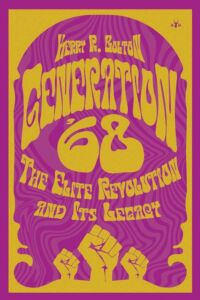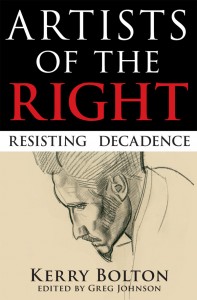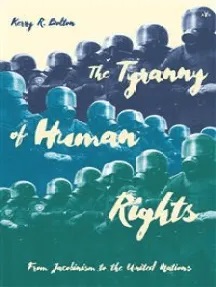The Establishment’s Radicals

You can buy Kerry R. Bolton’s book Generation ’68 here.
2,706 words
Kerry R. Bolton
Generation ’68: The Elite Revolution and Its Legacy
Allentown, Penn.: Antelope Hill, 2023
A Left-wing freakout took place among students across the world in 1968, most prominently in France, where student protesters occupied universities and factories, clashed with police, and chanted the names of prominent Communists and Leftists: “Marx! Mao! Marcuse!” France’s trade unions went on strikes in sympathy, and the event remains the largest general strike in French history. The protests were so intense that France’s then-President, Charles de Gaulle, briefly left the country.
The aftershocks of the 1968 protests continue to reverberate, both in France and in other places — with negative outcomes. Kerry Bolton, a white advocate from New Zealand, has published an outstanding book about the origins, supporters, and significance of the 1968 protests, the ideology of which has now become mainstream across the Western world.
The 1968 protests did not materialize out of the thin air. In fact, the ‘68ers were supported by the same establishment they claimed to oppose. The same sort of mixture of wealthy establishment financiers and idealists that we see among the ‘68ers first appeared in the early twentieth century, when the Jewish banker Jacob Schiff, who had emigrated from Germany but was based in the United States, funded the Japanese during the Russo-Japanese War and provided money with which to indoctrinate Russian prisoners-of-war who were being held by the Japanese with anti-Tsarist propaganda.[1]
Working alongside Schiff to bankroll Leftist aims were other financiers and Wall Street executives. These aims included organizing and funding the anti-white National Association for the Advancement of Colored People (NAACP), financing Leon Trotsky, and providing loans to the Bolsheviks. This network also funded Woodrow Wilson, and was sympathetic to Zionism.
Leftists selling poison
Although there are many Jews named throughout Bolton’s book, the 1968 protest movement wasn’t entirely a Jewish movement. Instead, it represented a systematic ideology based on the idea of an inclusive economy, where every person is a consumer and anything — no matter how dangerous, disruptive, or damaging — is for sale. Bolton calls this the Liberal International Order. This system relies on non-white and Leftist/mattoid violence to achieve the aims of those at its top. The ideology is ultimately nihilistic and supports white genocide.
The ideology of the ‘68ers, who soon came to be called the New Left, sells poison in the name of idealistic rebellion. Jennifer Bilek, a feminist and environmentalist, pointed this out in relation to its most serious and foolish manifestation: transgenderism. Bilek writes:
Transgenderism, a purported civil rights movement, now intersects at every juncture of the global marketplace. It is hard to remember it came out of the medical industrial complex as a term for the most intense body dysphoria. Children are being prescribed puberty blockers and cross-sex hormones, sterilized, and groomed into lifelong medical patients and consumers in more than 50 U.S. gender clinics that weren’t here ten years ago.
Selling poisons such as transgenderism is not new. Edward Bernays, Jew who was the pioneer of public relations, once paid a group of attractive women involved in a “woman’s rights march” in 1928 to light up cigarettes in front of reporters’ cameras. This stunt helped to expand the market for cigarettes — and its associated health problems.
The Cold War
By the early 1940s, Leftists had successfully followed the Fabian Society’s strategy across the English-speaking world and captured many of the major cultural institutions. One of them was the London School of Economics. “The LSE,” writes Bolton, “has educated policymakers and executives throughout the world, playing a leading role in the creation of our rootless managerial and intellectual global bureaucracy” (p. 34). The LSE was founded and funded by bankers in London and on Wall Street. Students and alumni of the LSE supported the ’68 protests and went on to shape future political movements, such as Tony Blair’s New Labour Party.
An organization which ended up going into the ‘68ers mix was the National Student Association. Key leaders of the New Left, such as Tom Hayden, were involved in the NSA in the late 1950s and early ‘60s. It grew out of a group of two dozen students who were selected by the CIA to attend the Soviet-sponsored Prague World Youth Congress in 1946. The purpose of this effort was to promote the American liberal order in Eastern Europe and oppose the Soviet Union. Soon thereafter the NSA became a CIA-funded asset, although this remained a secret until a Leftist magazine, Ramparts, exposed the connection in 1967.
The CIA’s strategy to fund the NSA was based on the idea that Leftist organizations could be shaped along anti-Soviet lines. The CIA also realized that it could fund other “student associations” abroad through NSA-affiliated sub-groups. This funding allowed New Left thought to spread from American universities to Europe and elsewhere. Bolton writes:
It is no real mystery . . . how and why the 1968 student riots quickly spread from the US to Europe and into the Soviet bloc. A liberal-democratic internationale of students had been rigorously planned and funded for twenty years. It was no more mystery, and no more spontaneous, than the color revolutions across Africa, Asia, and Eastern Europe, organized and funded by the same interests. (p. 47)
Many of the activists involved with the NSA knew they were beholden to the CIA. They justified it by claiming that the CIA was “liberal and progressive,” while the FBI was “reactionary and authoritarian.” Tom Hayden, one of the top New Leftist activists of the time, pointed to the fact that the FBI had investigated him to make the claim that he was in fact an anti-establishment martyr. Such investigations were not limited to the Left, however, and also extended to Right-wing organizations such as the John Birch Society and individuals such as Merwin K. Hart and Gerald L. K. Smith.
Feminism

You can buy Kerry Bolton’s Artists of the Right here.
Feminist icon Gloria Steinem likewise had CIA connections. She worked for the Independent Research Service, which was a CIA front group, and ran the IRS’ press bureau at the 1959 Vienna Youth Festival. She later justified her actions by insisting that the CIA had been opposed to the anti-Communist crusader, Senator Joe McCarthy.
It is very likely that Steinem’s meteoric rise to the status of a feminist icon was due to her CIA connections, and through that to Wall Street establishment figures. Feminism, however, grew into a nagging problem for the New Left. Bolton writes that “[f]eminists became an important, albeit disruptive, component of the New Left” (p. 64). Many of the New Left’s most violent terrorists were women. Feminists also used the New Left’s adoption of the Maoist technique of the “struggle session” to berate male Leftists by accusing them of being part of the “white male patriarchy.” Tom Hayden called these sessions a form of torture.
This new, more aggressive form of feminism was first enabled by Herbert Marcuse when he declared that women are an oppressed revolutionary class. Marcuse further claimed that the definitions of “female” and “feminine” are “socially conditioned.” This eventually led to today’s LGBT movement, which has, “. . . ironically, caused deep rifts within the feminist movement, with old-line feminists now finding accord with conservatives in rejecting transgenderism as an affront to women” (p. 65).
The Port Huron Statement
The New Left’s 1962 manifesto, the Port Huron Statement, was not as radical as has been claimed. In fact, it was very much in line with what the American Jacobins Woodrow Wilson wanted in his Fourteen Points and Franklin D. Roosevelt wanted in his Atlantic Charter. The Port Huron Statement was also closely aligned with the values of the Ford, Rockefeller, and Carnegie foundations.
The manifesto envisions a world free of starvation, terror, and war. It looks good on paper, but in practice the ideals behind it have dragged America into wars in Libya, Syria, Iraq, Yugoslavia, and elsewhere that were of very little benefit to Americans. The Port Huron Statement also endorses international banking schemes as well as spreading industrialization to other countries, thereby sending American jobs abroad, as of course ended up happening in subsequent decades. The Port Huron Statement is also anti-Soviet, stating:
Conventional discussion [about Cold War issues], to be sure, sometimes corresponds with realities: especially the attacks on the Soviet failure to establish democratic institutions, the irresponsibility of Soviet military policy, the phony Soviet equation of centralized, bureaucratic planning with the “triumph of true socialism”; and the numerous small and large denials of human dignity rationalized inadequately by appeals to history, posterity, or the “imperatives of revolution”.
Race riots
The most lasting damage inflicted on white Americans in the 1960s was the “civil rights” revolution. The mainstream narrative about it is that a band of plucky sub-Saharans, along with a few liberal whites and Jews, got together to fight the American South’s establishment, and that justice triumphed against the odds.
The reality was quite different, however. In fact, the “civil rights” movement had been supported by the American establishment since long before the 1960s. Wall Street financiers had already established the NAACP in 1909, and in the early 1960s the billionaire, then-Governor of New York, and future Vice President Nelson Rockefeller[2] was financially supporting the sub-Saharan Saint, the Reverend Doctor Martin Luther King, Jr. Rockefeller even provided King’s bail money when he was (justly) imprisoned in Birmingham, Alabama.
Ordinary whites in the South were completely cut off from the federal power structure at the time, and the establishment provided a great deal of support to the “civil rights” demonstrators. At a segregationist protest held at the University of Mississippi in 1962, for example, US law enforcement agents shot and killed French journalist Paul Guihard, who had planned on writing a sympathetic account of the white protesters. Another white man, Ray Gunter, was also killed. No officials were ever punished for these killings, and the violence came to be seen as a turning point against segregation. Likewise, the famous “Bloody Sunday” confrontation between the Alabama State Police and unarmed “civil rights” marchers at the Edmund Pettus Bridge in Selma in 1965 was likewise a government-sponsored affair. The “civil rights” marchers were in fact flanked by US Army soldiers and were even provided with air support.
In the North, property developers used integration and “civil rights” laws to destroy white ethnic neighborhoods. Nelson Rockefeller used his position as New York state’s Governor to fund what became sub-Saharan and Puerto Rican street gangs, who then terrorized whites while fighting with each other over turf and resources. By the end of Rockefeller’s tenure as Governor, the state was nearly bankrupt and New York City had been overrun by criminal elements.
The populist revolts
There have been several revolts against the domination of the Wall Street establishment and its allies in the government in American history. One was Senator Joe McCarthy’s anti-Communist crusade. Then, in 1964, Barry Goldwater won the Republican nomination, thus undercutting the East-Coast establishment’s hold on the party. Goldwater’s success sent the establishment into panic mode. “Psychologists” insisted he was “crazy,” and sub-Saharans were given a free hand to riot outside the venues where Goldwater spoke. He remained unintimidated, however, and voted against the 1964 Civil Rights Act, which has become an illicit second constitution. He also pointed out that the liberal establishment’s policy in Vietnam was inconsistent and likely to end in defeat.
Goldwater’s run also changed politics in such a way that the two main political parties began to diverge. Bolton paraphrases what historian Carroll Quigley has said about the 1964 election being “. . . partly a struggle between the isolationism or nationalism of the petty bourgeoisie and the internationalism of Wall Street” (p. 171).
Paris in 1968 and beyond

You can buy Kerry Bolton’s The Tyranny of Human Rights here.
Given that the New Left was funded by the CIA as part of a strategy to defeat the Soviet Union by drawing anti-Soviet Leftists into the American establishment’s web, it naturally follows that the New Left was used against any American ally that opposed the interests of the US establishment. Throughout the 1960s, the French were a reluctant and troublesome NATO partner; as such, given the New Left’s CIA connections, the Paris 1968 protests could be seen as a CIA operation no different from later US-backed “color revolutions” around the world.
After having started out as street activists, many of the New Left’s main figures joined the establishment as they grew older. For example, Jerry Rubin, originally known for writing a vulgar New Left book called Do It!: Scenarios of the Revolution in 1970, became a stockbroker. Those who had become actual terrorists, such as the members of the Weather Underground, turned themselves in and suffered little, if any, punishment, for their deeds. Many became professors and other establishment professionals. Some kept asking questions, however, and in some cases even shifted to supporting the Right, such as Horst Mahler of the German terrorist group, the Red Army Faction. Mahler later joined the National Democratic Party and became a vocal opponent of Jewish subversion. He has served several prison sentences for his later activism, and naturally has been smeared by the establishment. Bolton writes:
Since his conversion to the right, Mahler’s life has been one of continual persecution, not for terrorism, but for thought crimes. His treatment at the hands of the establishment is a stark contrast to the positions maintained by the former German, British, and American left-wing extremists, who are often lauded for their “idealism.” (p. 411)
The same double standards were applied to sub-Saharan activists as well. Supporting Black Nationalism was, for a short time, a status symbol among the wealthy, and Black Panther members were sometimes honored in upper-class homes. But once these activists shifted from “civil rights” to supporting black self-sufficiency and separationism, these same establishment figures stopped funding them. This is unsurprising given that “civil rights” has merely ended with blacks becoming a different type of slave on a different type of plantation.
The CIA’s strategy
The Port Huron Statement gives the sense that it was written by precocious, yet still juvenile minds. One passage, for example, begins with: “When we were kids the United States was . . .” Nevertheless, William Penn would have agreed with most of it. In fact, the Port Huron Statement’s anti-Soviet statements are entirely in line with Penn’s anti-Ottoman ideas as presented in his Essay Towards the Present and Future Peace of Europe, which encouraged Europe to form a parliament both to facilitate commerce and guard
. . . against the Inroads of the Turk, in their most Prosperous Fortune. For it had been impossible for the Port, to have prevailed so often, and so far from Christendom, but by the Carelessness, or Willful Connivence, if not Aid, of some Christian Princes. And for the same Reason, why no Christian Monarch will adventure to oppose, or break such an Union, the Grand Seignior will find himself obliged to concur, for the Security of what he holds in Europe . . .
The question therefore arises: In the context of the Cold War, was the CIA’s plan to counter the Soviet Union by creating an anti-Soviet Left justified or not? Given that the Soviet Union was a very dangerous enemy, creating a Leftist diversion was a stroke of genius. But this strategy also came with a cost. If the Soviet Union was a malignant cancer, the New Left was a form of chemotherapy which killed the cancer only slightly faster than the patient himself. The Soviet Union is gone, but the New Left’s harmful side effects remain.
Notes
[1] “Woke capital”’s first victory came during the Taft administration (1909-1913), when judge William Cather Hook was nominated for the Supreme Court. As a supporter of segregation and Theodore Roosevelt’s anti-trust measures, his nomination was resisted by the NAACP, which was then almost entirely funded and led by ethnonationalist Jews. The attack and displacement of old-stock American whites was in full swing as early as 1912.
[2] Nelson Rockefeller (1909-1979) was the wealthy scion of John D. Rockefeller, the founder of Standard Oil. A lifetime member of the American political establishment, Rockefeller did everything he could to harm the interests of white Americans through his globalist economic ideas and his support for “civil rights.” Bo Gritz, in his book Called to Serve, raises the possibility that the anti-Nixon coup of 1974 could have been planned with the intention of allowing Rockefeller to become President, first by replacing Nixon’s Vice President with Ford, then replacing Nixon with Ford, and finally, replacing Ford with Rockefeller. Two assassination attempts that were made on Ford in September 1975 failed, however.




